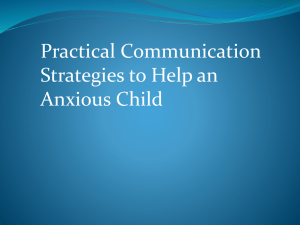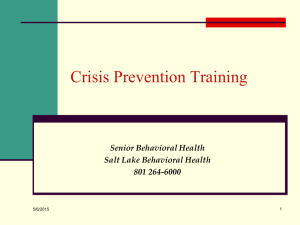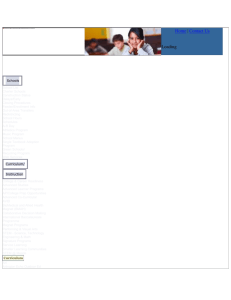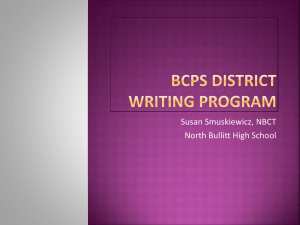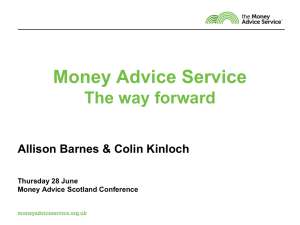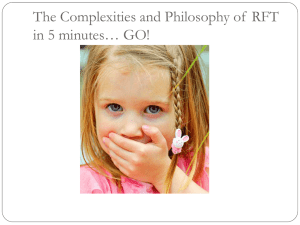Challenging Behavior Session 1 PPT
advertisement
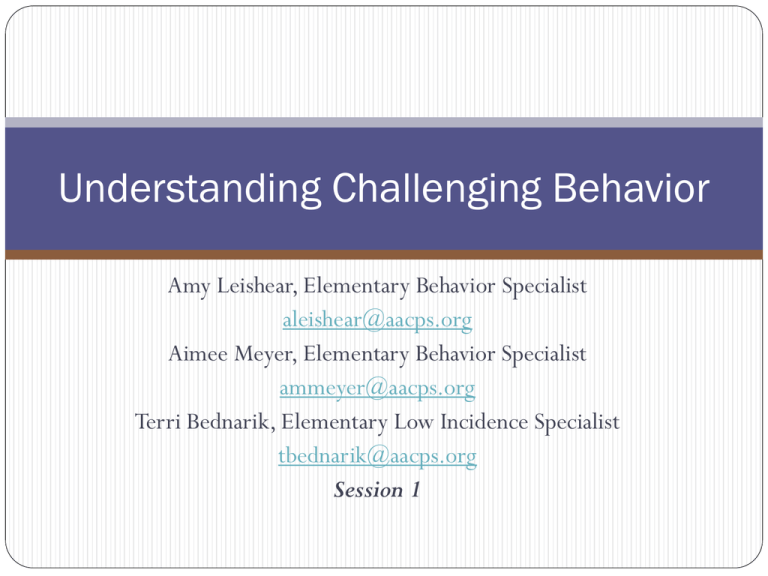
Understanding Challenging Behavior Amy Leishear, Elementary Behavior Specialist aleishear@aacps.org Aimee Meyer, Elementary Behavior Specialist ammeyer@aacps.org Terri Bednarik, Elementary Low Incidence Specialist tbednarik@aacps.org Session 1 AACPS Division of Special Education Para-educator Training Videos Pre Assessment Name: School: Date: 1. 2. 3. 4. 5. What do you think are the four levels of behavior that a student may have? What impact will adult response have on a child's behavior? Why would a student question an adult? Why should the adult develop a therapeutic rapport with the student? Why is it important to remain calm when a student is losing control? The Big Picture Identify the four levels of student behavior and the corresponding staff attitudes and approaches that are most appropriate at each level. Identify best practices for utilizing verbal intervention strategies to address challenging behavior. An Integrated Experience The concept that the behaviors and attitudes of staff members have an impact on the behaviors and attitudes of students and vice versa…. Crisis Development Model Crisis Development/Behavior Levels 1. Anxiety Staff Attitudes/Approaches 1. Supportive Proxemics (personal space) Kinesics (body language) Paraverbal Communication Definitions 1. Anxiety: a noticeable increase or change in behavior (pacing, wringing of the hands, finger drumming, etc…) Supportive: an empathic, nonjudgmental approach attempting to alleviate anxiety. Crisis Development Model Crisis Development/Behavior Levels 1. Anxiety 2. Defensive Staff Attitudes/Approaches 1. Supportive 2. Directive Definitions 2. Defensive: the beginning stage of loss of rationality. At this point an individual often becomes belligerent and challenges authority Directive: an approach in which staff members take control of potentially escalating situation by setting limits Crisis Development Model Crisis Development/Behavior Levels 1. Anxiety 2. Defensive 3. Acting-Out Person Staff Attitudes/Approaches 1. Supportive 2. Directive 3. Nonviolent Physical Crisis Intervention Definitions 3. Acting-Out Person: the total loss of control which often results in a physical acting-out episode. Nonviolent Physical Crisis Intervention: Safe, nonharmful control and restraint techniques used to control an individual until he can regain control of his behavior: Used only as a last resort, when an individual presents a danger to self or others. Crisis Development Model Crisis Development/Behavior Levels 1. Anxiety 2. Defensive 3. Acting-Out Person 4. Tension Reduction Staff Attitudes/Approaches 1. Supportive 2. Directive 3. Nonviolent Physical Crisis Intervention 4. Therapeutic Rapport Definitions 4. Tension Reduction: decrease in physical and emotional energy which occurs after a person has acted out, characterized by the regaining of rationality. Therapeutic Rapport: an attempt to re-establish communication with an individual who is experiencing Tension Reduction Verbal Escalation Continuum Defensive 1. Questioning 1. Questioning: A. Information seeking B. Challenging Interventions A. Rational response B. Redirect/restate original direction (avoid a power struggle) The CPI Verbal Escalation Continuum Defensive 2. Refusal 1. Questioning 2. Refusal: Slight loss of rationality/noncompliant Interventions *setting limits (choices and consequences) with follow through * allow processing time The CPI Verbal Escalation Continuum 3. Release Defensive 2. Refusal 1. Questioning 3. Release: Venting, letting off steam Interventions Allow them to vent and listen to what they have to say The CPI Verbal Escalation Continuum 3. Release 4. Intimidation Defensive 2. Refusal 1. Questioning 4. Intimidation: Threatening self or others Interventions Take them seriously and seek assistance The CPI Verbal Escalation Continuum 3. Release 4. Intimidation Defensive 5. Tension Reduction 5. Tension Reduction: Regained rationality; decrease in energy Interventions * Therapeutic rapport * Document incident 2. Refusal 1. Questioning Keys to Setting Limits Limits should be simple and clear Limits should be reasonable Limits should be enforceable Verbal Intervention Tips and Techniques Do Don’t • Stay calm • Overreact • Be supportive • Threaten • Monitor paraverbal • Be judgmental • Give choices/consequences • Use sarcasm • Avoid power struggle • Invade personal space • Redirect • Make false promises • Listen • Give too many choices • Be aware of kinesics/proxemics Precipitating Factors: Internal and external causes for acting out behavior that staff have little or no control over. •Loss of power •Displaced anger •Fear •Failure •Physiological factors (lack of sleep, hunger) •Psychological factors (mental illness, medication) Rational Detachment: Staff maintains control of his or her own behavior. Don’t take acting-out behavior personally. * hobby * someone to talk to * exercise * self-care * social life The Big Picture Identify the four levels of student behavior and the corresponding staff attitudes and approaches that are most appropriate at each level. Identify best practices for utilizing verbal intervention strategies to address challenging behavior. AACPS Division of Special Education Para-educator Training Videos Post Assessment Name: School: Date: 1. 2. 3. 4. 5. Define the integrated experience. List at leaste three behaviors that you may observe in a student when they are becoming anxious. What is the Crisis Development Model? Communication when responding to challenging questions should be ________________________________________________________ ________________________________________________________ Define Rational Detachment.
